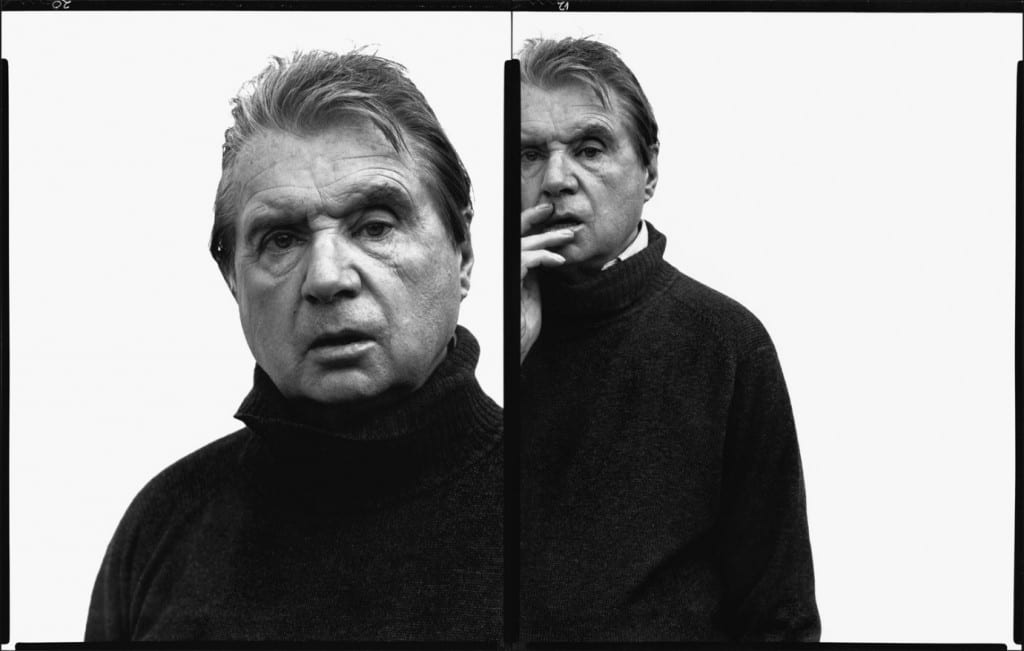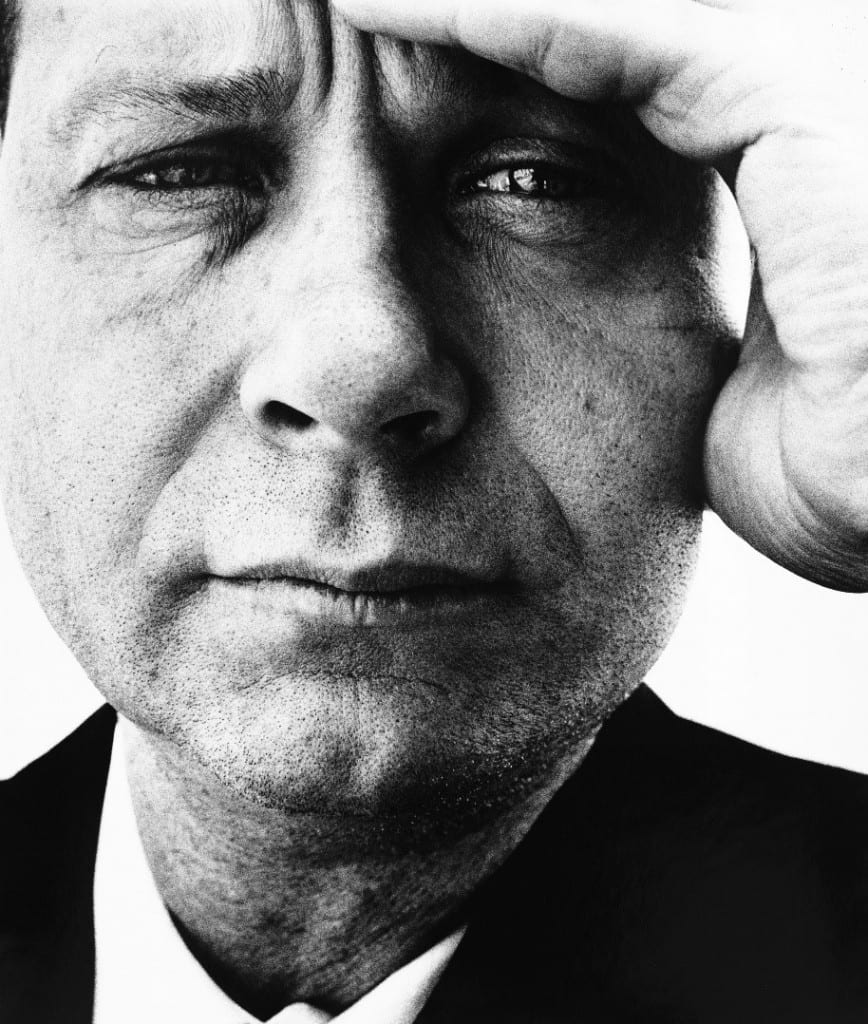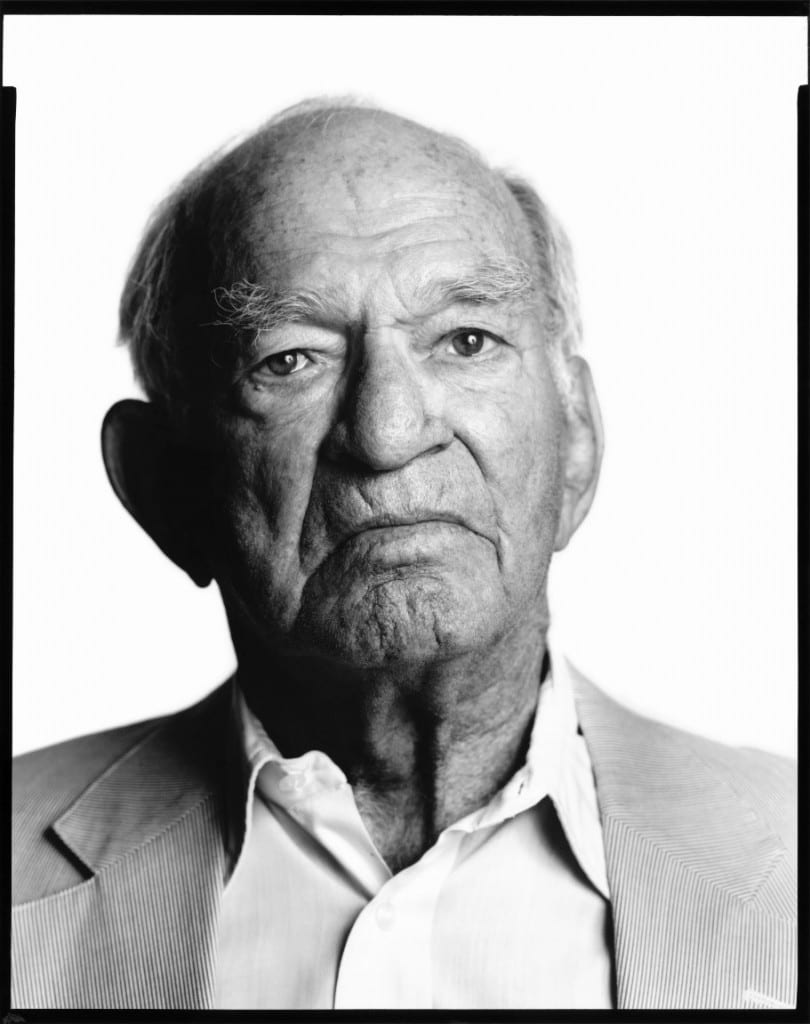This image (above) is split up into two sections. The left side of the image is of a male, approximately in his fifty’s, looking directly at the camera, with his head at a slight slant to the left. The photograph on the right is of the same man but with his right hand touching his right side of his face and mouth. The right side of the image is also slightly zoomed out compared to the left photograph.
In both images, the darkness of the man’s jumper creates a strong contrast throughout the image as this is the darkest part of the photograph compared to his facial features and white background.
It is as if Richard has photographed a short series of two photographs, one before Richard tells him something shocking and the next, his reaction to what Richard has just said. I believe that Richard has managed to capture an element of surprise and astonishment within the character being photographed.
I also like the layout of the two images because both cross and hide slightly different parts of the man being photographed, adding a psychological approach to the analysis of the overall image being that there is more to be seen within the character within the photograph.
In my opinion, I really like this image because of the composition, high contrast and how Richard has captured the emotion of the man in the frame.
Major Claude Eatherly, pilot at Hiroshima, Galveston, Texas, April 3, 1963
This photograph (above) was taken by Richard on the 3rd of April, 1963. The man in the photograph is Major Claude Eatherly, a pilot during World War two who was on the bombing mission during the Hiroshima bomb drop on the 6th of August 1945. Claude scouted ahead before the bomb drop by Tibbets, piloting the Enola Gay, to see if the weather was clear which it was just before they dropped they nuclear bomb.
In the photograph, you can see Major Claude Eatherly looking directly into the camera, with the framing of the photograph very tight and close to the subject. This tightly cropped feel towards the subject gives the photograph a strong mood and atmosphere.
The lighting throughout the photograph also shows a dramatic mood expressing a very high contrasting image. The lighting within the photograph is harsh, unlike a diffuse lighting setup. Looking at the photograph head on, the left side of the man’s face is bright and shows little tonal definition. As you look towards the right side of the photograph, the image becomes darker and a lot more details, textures and facial structure are revealed.
The expression on Major Claude Eatherly’s face is far from happy or upbeat, instead, he looks depressed, troubled and sorrowful. As we understand the backstory of who the man in the photograph is, knowing that he gave the all clear to Tibbets about the weather forecast, he looks like he feels solely responsible for the death of over 90,000 people.
I feel that Richard Avedon has managed to capture the emotion and grief that the Major Claude Eatherly is currently going through.
This photograph (above) was taken by Richard, title unknown, model unknown.
In the photograph you can see an elderly man who is looking into the camera with more of a frown on his face rather than a smile. The lighting throughout the image is very powerful with one 1/4 of his face covered in a shadow, the next quarter of his face has very defined textures and tones which leads onto the next quarter which has less defined textures and the final quarter where the light begins to fall off his face into the backdrop.
The photograph has a shallow depth of field as his eyes, nose and eye brows are sharply in focus but his ears and back of his head are blurry.
The gentleman in the photograph is wearing suit and shirt. My first impressions of the man, is that he is a war veteran. This is because of the expression on his face and the age of the man. Or, because the man is on his own, suggesting he may have once had a wife or child that he has recently lost. For me, the photograph looks like it was taken just before the man started crying or expressing strong physical emotions in front of the camera.
In my opinion, the photograph has been taken at time in which you can really read more into the expressions on the man’s face. The technical aspects within the photograph also show a stronger mood and emotion throughout the photograph as well capturing the strong contrast between the light and dark elements of the image.
This photograph (above) on the Vogue front cover produced and published in 1950 was taken by Erwin Blumenfeld.
My first impressions of the photograph are its minimalistic feel and approach. The image is composed of four important elements; the eye brow, eye, mouth and beauty spot.
Between the eye brow and eye, there is a subtle amount of texture and toning that gives the photograph perspective and structure. Below the eye, towards the bottom left of the cover there what looks to be a graphic print of a female mouth. This stands out as a very vibrant part of the cover because of how red the lips are compared to the rest of the photograph. To the right of the lips there is a very subtle beauty spot that adds personal element to the cover.
I believe that the subtle elements throughout the photograph lend itself to a very sophisticated style and approach. The composition and layout of all the elements lend itself to the final composition of the cover design including all of the text and titles.
In my opinion, I think this is such a strong front cover because of its minimalistic style making you focus on just those elements including the subtle beauty spot which is an important factor because Vogue is a fashion magazine, focusing on beauty.
This photograph (above) taken by Erwin is slightly different to his typical forms of photograph.
The model in the image looks quite threatening, strong, with her eyes looking like a panther like you should avoid coming into contact with her. Erwin referred to using the term ‘psychological portraiture’ which I think is evident in this photograph giving off these strange emotions and signals.
The model in the photograph isn’t looking directly at the camera but off to the left of the frame where she is staring into the distance. The model is wearing an excessive amount of jewellery around her neck, with also an earring attached to her left ear. What makes this photograph so noticeable is the strong contrasting lines that are running vertically up and down the image.
At a first glance, the photograph looks like it hasn’t been developed and that it is the copy of the negative. Looking further into the structure of the photograph, I believe that it has been developed and that the vertical lines actually make it an illusion that makes you believe it is a picture of the negative.
I personally like this effect and would like to express it in a different way in my own work.
This photograph (above) is titled ‘Humphery Bogart, 1946’. The man in the photograph is Humphery Bogart who played Leslie Howard in theatre productions.
The composition of the photograph, lighting and scene setup really captures the personality of the model in the photograph. The man in the photograph is holding a cigarette in his right hand with his left hand like he is about to put both of his hands together. Humphery is looking away from the camera like something has just caught his eye or focusing his attention on something else.
The lighting within the photograph is very moody, with the right side of Humphery’s face brightly illuminated, the middle of his face slightly darker, then a small section where it is even darker and finally a harsh bright light lighting up the far left third of his face.
I would estimate that the shutter speed that Yousuf used to photograph the scene was fairly slow, about 1/30th of a second to capture the blurriness of the smoke drifting upwards towards the top of the frame. 1/30th of a second is slow enough to capture the motion blur of moving elements within the scene (in this case the smoke) but also allowing the main subject, providing that they are still, to be captured in a solid state without distortion or blurriness.
In my opinion, I think the technical aspects within this photograph are very strong with the subject being well composed, the correct exposure throughout the photograph even with variation of different lighting brightness’s and the structure of the photograph well executed with the smoke blurry but the model in the photograph still remaining sharp.
This photograph (above) is of Albert Einstein, taken in 1948. The lighting in the photograph portrays Einstein to have a content, comfortable and relaxed state of mind. Yousuf said that “one did not have to understand his science to feel the power of his mind or the force of his personality” (Yousuf Karsh, para 1).
Just this short sentence says that Yousuf was taken back by Albert’s personality and that Albert was not at all boastful or arrogant in expressing his knowledge and intelligence.
The structure and make-up of the photograph really highlights Albert’s gentle and tranquil personality. This is done in several ways: the lighting, composition and model expression.
The lighting throughout the photograph is very delicate and graceful as you are able to see all of Einstein’s features. The lighting also has reflective properties because it has a similar brightness and tone on the left and right sides of his face. The centre of his face is slightly brighter, almost conveying a halo above Einstein’s head. The left side of Einstein’s head also shows a subtle lighting technique called Rembrandt lighting. Rembrandt lighting is the triangular
The composition of the image relates strongly with the expression and body language that Einstein is displaying. This is because Einstein is holding his hands up towards his face, looking slightly off to the right of the camera. His eyes are in the upper third of the frame, with his hands in the lower third of the photograph creating a balance throughout the portrait.
I believe that this portrait photograph of Albert Einstein expresses the calm and tranquil elements of his personality though just the physical signs of the structure throughout the photograph such as: lighting, composition and model expression.
Next Steps
After all the research I have conducted, I would like to experiment in photographing in a ‘studio like’ set up. As I do not have access to a studio, I will have to improvise with the technical techniques to produce something of that standard. I will do this by using different lighting setups that are already available to me such as natural lighting, ambient lighting and point lighting like a projector or lamp without a diffuser . Gathering inspiration from Erwin Blumenfeld and his psychological portraiture example, I would like to use a projector to create a similar effect with the different textures and high contrast style that is shown in Erwin’s work. I would also like to produce work that has more of a diffused style with less harsh lighting. I would like this to be executed in an outdoor setting without direct sunlight.







